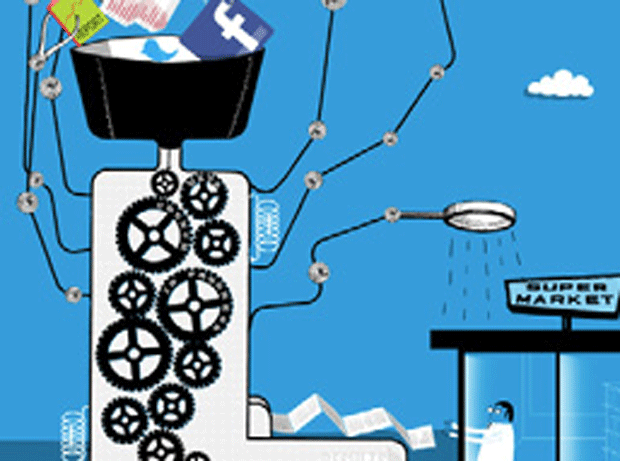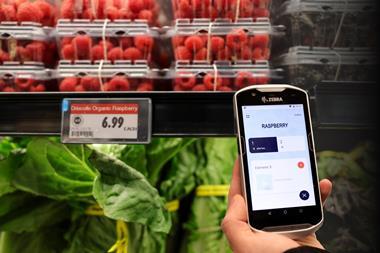
Big data spells a big opportunity for predictive analytics. For decades, analytics software has helped the major multiples predict the future. By crunching sales data and mixing it with other information, whether economic, weather-related or market research, these tools have been used to predict future demand, helping reduce waste in the supply chain, determine which special offers will appeal to customers and improve sales and retention rates.
The downside? Historically, it’s been an expensive business requiring highly skilled users. It also takes time, creating a lag between collecting data and making forecasts.
Not any longer. Tools are becoming cheaper and easier to use. Many systems are also becoming more sophisticated and powerful, crunching through data so swiftly, businesses can make predictions virtually as data is collected.
They’re not necessarily calling on tried and tested data sources either. Today, so-called ‘big data’ draws from myriad sources, including social media, mobile phone location and call-centre voice recordings.

Meet the analyst
From the use of Pi as his LinkedIn profile picture, it’s not hard to guess that Dr Laurie Miles is a mathematician.
“The real geeks wear the term with pride,” says the head of analytics in the UK for SAS, the company that provides analytics tools to Sainsbury’s, Waitrose and Tesco.
With the rise of data in business, statisticians like Miles have become more important. “It is all about business value,” he says. “There are so many problems you could solve with data, but many of them are not worth solving because there’s no money in it for the organisation.”
As such, a core part of the analyst’s work is figuring out the value of their own predictions.
“If I can increase the forecast accuracy by 10%, what does that mean for the business? It might mean they throw away fewer perishable goods, have fewer unhappy customers or they have to hold less stock,” he says. “You look at what the problem is and think about how you can solve it and then you calculate what that means for the business.”
Despite their reputation, analysts do not only follow rules and crunch numbers, he adds. “You might have this picture in your mind of an analyst as someone in a white lab coat, who is a little bit introvert,” he says. “Those guys certainly exist, but the great analysts are not only numerate but also creative, because sometimes you need to come up with a different way of looking at a problem in order to formulate it into something you can solve.”
Attitudes are also changing to data and data scientists as a new generation of managers comes up through the ranks, he notes. “People are getting much more used to data. There is a younger generation of senior business execs who had their formative years when technology was available.”
Which is why Miles predicts such a big future for predictive analytics.
Together, these changes are set to revolutionise predictive analytics for the grocers - and not just for the big boys. Why? Because predictive analytics promise to help in that age-old quest: determining the right pricing strategy.
Using analytics to forecast the impact of pricing strategy not just on your own sales but on the competition will soon be a prerequisite among top retailers, believes Colin Linsky, predictive analytics worldwide retail sector leader for IBM. “It is becoming more prevalent, and it is going to become table stakes [a minimum entry requirement].”
Adoption will also be driven by the spread of e-commerce, he predicts. Because online retailers are able to price more dynamically, bricks-and-mortar outlets are having to react more rapidly, particularly as consumers may have access to pricing data on a smartphones as they browse in store.
“The only way to keep up is by aggressively managing the situation [with analytics]. You have to work quickly because the mentality of a shopper is changing, because of technology, but also times are harder,” says Linsky.
The good news is that retailers can now use analytics to build a more detailed understanding of their customers, by placing them in narrower segments so they can be targeted with special offers on their smartphones while in-store. The bad news is that combining this with dynamic pricing demands higher standards in the way analytics systems are used, says Linsky. “You can’t just stick your finger in the air,” he notes.
Retailers also have to cast their net wide when gathering data to determine the effects of pricing changes, adds Vivian Braun, IBM’s business analytics distribution sector lead. This includes analysing text from social media to gauge what consumers think.
“Are consumers realising that you are sharp on pricing? Do they care? Do they change their shopping habits if you change your pricing in a certain category? Listening in on social media, and deploying it into that big pool of data, is another important area to go into,” she explains.
However, John Dawson, director of analytics company MarketingQED, says there are limits to understanding how changes in prices are hitting the competition. “What a retailer does itself is a far bigger determinant on volume than what competitors do,” he says. “If I do something positive and cut some prices, I might generate 5% footfall, but that will drag, generally speaking, from all retailers. The pain is spread across the market, not just one store.”
MarketingQED modelling software, which is designed for users who are not experts in statistics, aims to help retailers make decisions about pricing changes informed by a broad spread of predictions. It enables category managers to group the data into store formats or geographies and build a model of a particular category to help determine price elasticity or the effect of removing an item from that category.
“As we promote one item, say a Pepsi four-pack, how much of the volume we create is going to be additional to the category? How much is stolen from other members of the category? This will tell you how sensitive to promotions each of the items is,” says Dawson. “That’s important for retailers in deciding which deal can create net value.”
Factoring assumptions about manufacturing costs, the software can also help retailers work with suppliers to predict a win-win pricing strategy for both parties. “You can start to war-game and say where we will both do well out of this and which items I want to promote and which of my supplier’s I wish to favour,” adds Dawson.
“The only way to keep up is by aggressively managing the situation with analytics”
Colin Linsky, IBM
Another potential game changer in this new era of analytics is the wealth of availability of tools in the cloud. Businesses can now access the software via the internet on a pay-as-you-go basis, avoiding capital investment in hardware and expensive software licenses.
The cloud also puts highly sophisticated statistical techniques in the hands of all retailers, big and small, and allows them to better analyse data from in-house experiments, for example. Online retailers can test a new website design at low cost by comparing its performance with the old design based on the behaviour of 100,000 users in sample groups.
The technique is more difficult in bricks-and-mortar retail environments, because cost prevents these retailers creating large sample sizes, says Jim Manzi, chairman of Applied Predictive Technologies, whose customers include Asda.
However, he claims, APT cloud-based Test & Learn software can help bricks-and-mortar retailers draw better conclusions from small samples, therefore improving the quality of decisions. “The rule of thumb is that fully deployed, Test & Learn should be able to increase total gross profit by 4% to 5%.”

Case study: Atheon Analytics
Atheon Analytics, winner of Technology Supplier of the Year award at The Grocer Gold Awards, started life as a consultancy helping retailers better understand how data can improve performance.
But founder and MD Guy Cuthbert wanted to get back to his roots in software development and creating new technology. When he started using a data visualisation tool called Omniscope from Visokio, he saw an opportunity to build technology around the system and help businesses see patterns in the data they hold.
In 2006, Cuthbert recruited Chris Fisher, who had recently left Walmart where he had been purchasing manager, and Ian Hall, who had worked as a buying manager at Tesco. “With the two of them having worked in buying roles, they knew how buyers thought and the challenges they faced and also the challenges faced by large fmcgs in how to process retailers’ data,” says Cuthbert, adding: “We had at our fingertips the tools that could address these problems in weeks when the typical cycle was months and years.”
In 2010, Atheon recruited Chloe Walton, who had worked in Sainsbury’s business finance unit.
Now a unified consulting and software firm, Atheon aims to use visualisation software to solve a number of retail data problems, with tools available through the cloud.
For instance, it has helped suppliers and retailers work together on price planning, says Cuthbert. “We are trying to connect buyers and suppliers to enable them to work with the same data and agree how they interpret it. When they sit down to discuss service levels, stock availability, whatever, often the parties have different stories from different metrics.”
By using analytics and data visualisation in this way, both parties can explore the data during a meeting, rather than work from static PowerPoint presentations, he says.
“We have a belief that both parties win by sharing information in a consistent way. Information in a highly interactive, visual form can then be explored by both parties to come to the same conclusions, maybe one conclusion is in the supplier’s favour and one in the retailer’s, but at least they are not debating who has the right picture of the data.”
Small firms get big data
While the big four supermarkets have been using predictive analytics techniques for a long time, smaller retailers have struggled to compete because of the high cost and need for people with strong data skills on site. But this is changing, says Richard Feest, head of ICT at Anglia Regional Co-operative. His grocery co-op has been using the tool Omnico to improve the targeting of customers offer and react to offers from competitors.
“If you are a small or medium-sized retailer, you’ve got to understand what the benefits of big data are, but you need to be able to deploy analytics in a way that is going to deliver benefits, otherwise you are never going to be able to compete with the big boys.”
Anglia Co-op encourages customers outside its membership to sign up for email offers. By analysing the baskets of customer taking up those offers, it begins to build a picture of their behaviour and predict the best future special offers for non-members. It also analyses special offers from other retailers to understand their mechanics and create a relevant competing offer for Anglia Co-op.
The need for speed
While cloud computing and the market new entrants are driving down the cost of using analytics tools, the incumbent players have not been standing still. SAS has been one of the leading analytics firms for many years and counts Sainsbury’s and Tesco among its customers.
Advances in ‘real-time’ analytics will prompt a significant step change in the use of these tools, believes Alex Fovargue, SAS sales consultant, retail customer insight, with experience at Sainsbury’s and Tesco’s customers data arm Dunnhumby.
“Predictive analytics have been around for more than 20 years. If you go back to Tesco Clubcard statements, they were targeted using SAS predictive models. They were doing that in a long lead time - every quarter - with three months to build models saying customer A should get product B. They are very sophisticated at doing that today.”
Partly driven by competition from online retailers, grocers are moving away from that long lead time to analysing data more rapidly, Fovargue adds.
Technical advances called in-memory analytics, which allow data to be stored and manipulated in solid state memory rather than on slower disc storage, are helping. Combined with electronic shelf-edge labelling, they enable retailers to approach pricing in a new way. “Retailers will be able to do things such as real-time pricing for customers, using predictive analytics, to secure the purchase,” Fovargue says.
Prices can be also personalised and communicated directly to mobile ‘wallets’ on consumers’ smart phones. “People will be paying on their mobile phones. Therefore why shouldn’t they be receiving offers on them?”
“Smaller retailers need to be able to deploy analytics in a way that is going to deliver benefits”
Richard Feest, Anglia Co-op
Providing consumers agree, mobile phones can allow retailers to pinpoint their location inside or outside the store. This information, coupled with historic data of buying behaviour, enables retailers to target consumers with special offers tailored to that individual, not to mention the time of day and location.
Data is becoming a new battlefield for grocery retailers, changing their relationship with consumers and suppliers alike. Analytics tools are becoming cheaper and more usable, as well as powerful enough to quickly make predictions based on real-time data.
Retailers who are better at exploiting these tools are more likely to stay ahead in the big data war games. “It comes down to the big data challenge of how you are able to handle that in real time,” says Fovargue.
And as Anglia Co-op demonstrates, you don’t have to be big to make the most of big data-driven predictive analytics… you just have to think big.














No comments yet